“My drawing is quite different!” Drawbacks of comparing generative drawings to instructional visuals
Abstract
This study tested how prompting learners to compare their drawings to instructional visuals affects their perceived and actual performance. Undergraduates (n = 116) created two drawings while studying a text on the human circulatory system. Then they made a series of retrospective and prospective judgments of their drawing performance and prospective judgments of their comprehension. In a subsequent restudy phase, students were randomly assigned to either compare their drawings to instructional visuals (compare group; n = 56) or to restudy the text and review their drawings without receiving instructional visuals (control group; n = 60), followed by a series of new judgments of drawing and comprehension. All students then completed drawing and comprehension post-tests. Results indicated that comparing one’s drawings to instructional visuals caused students to become underconfident in the quality of their drawings (lower retrospective accuracy) and overconfident in their future drawing performance (lower prospective accuracy). Exploratory analyses indicated that the compare group tended to make surface-level (rather than conceptual) comparisons when processing the provided visuals, such as attending to the aesthetic style or conventions used in the instructional visuals. Furthermore, despite a strong link between drawing and comprehension performance, comparing drawings to instructional visuals did not significantly affect students’ judgments of comprehension. These findings highlight potential drawbacks of comparing generative drawings to instructional visuals in learning by drawing.

 求助内容:
求助内容: 应助结果提醒方式:
应助结果提醒方式:


